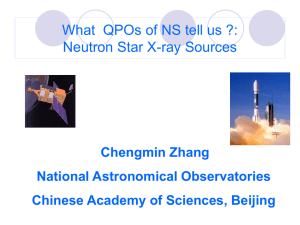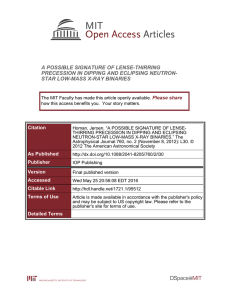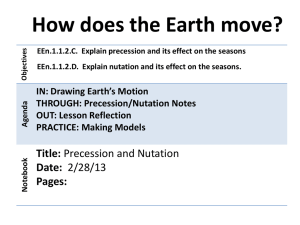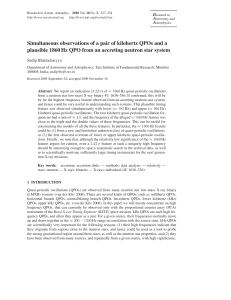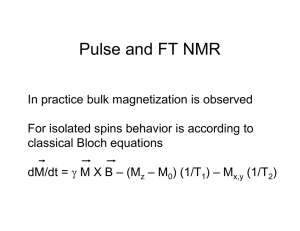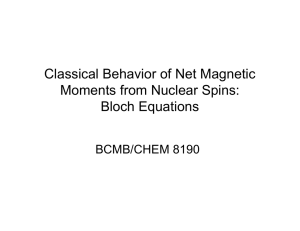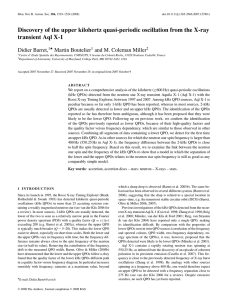LOW-FREQUENCY QUASI-PERIODIC OSCILLATION FROM FRAME DRAGGING
advertisement
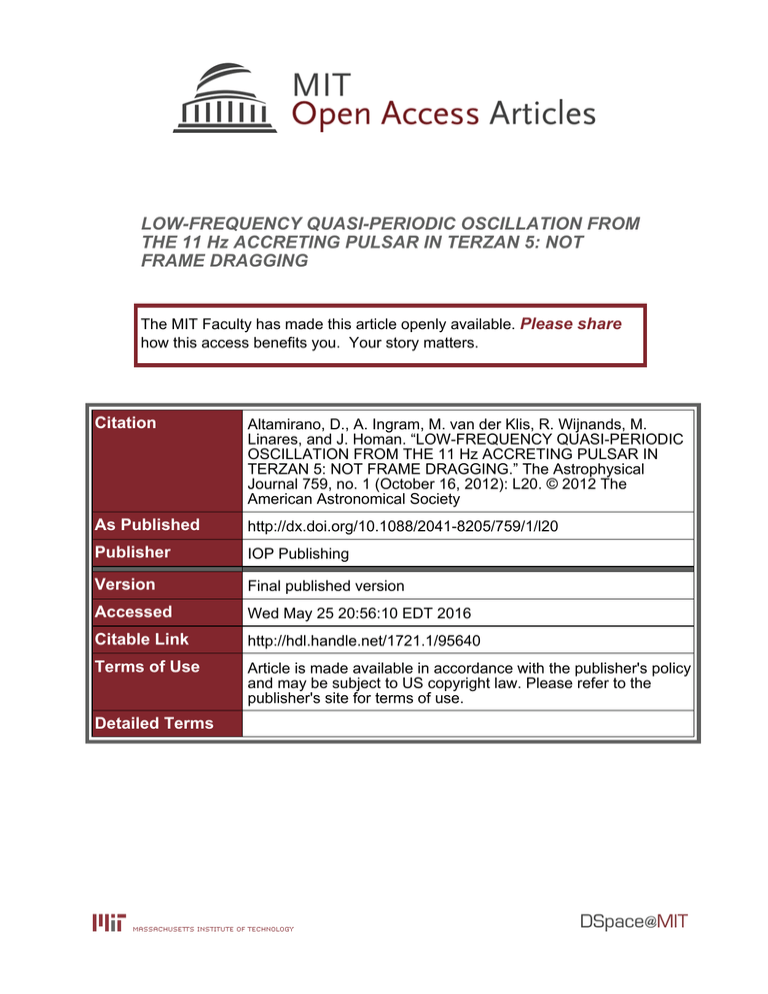
LOW-FREQUENCY QUASI-PERIODIC OSCILLATION FROM THE 11 Hz ACCRETING PULSAR IN TERZAN 5: NOT FRAME DRAGGING The MIT Faculty has made this article openly available. Please share how this access benefits you. Your story matters. Citation Altamirano, D., A. Ingram, M. van der Klis, R. Wijnands, M. Linares, and J. Homan. “LOW-FREQUENCY QUASI-PERIODIC OSCILLATION FROM THE 11 Hz ACCRETING PULSAR IN TERZAN 5: NOT FRAME DRAGGING.” The Astrophysical Journal 759, no. 1 (October 16, 2012): L20. © 2012 The American Astronomical Society As Published http://dx.doi.org/10.1088/2041-8205/759/1/l20 Publisher IOP Publishing Version Final published version Accessed Wed May 25 20:56:10 EDT 2016 Citable Link http://hdl.handle.net/1721.1/95640 Terms of Use Article is made available in accordance with the publisher's policy and may be subject to US copyright law. Please refer to the publisher's site for terms of use. Detailed Terms The Astrophysical Journal Letters, 759:L20 (5pp), 2012 November 1 C 2012. doi:10.1088/2041-8205/759/1/L20 The American Astronomical Society. All rights reserved. Printed in the U.S.A. LOW-FREQUENCY QUASI-PERIODIC OSCILLATION FROM THE 11 Hz ACCRETING PULSAR IN TERZAN 5: NOT FRAME DRAGGING 1 D. Altamirano1 , A. Ingram2 , M. van der Klis1 , R. Wijnands1 , M. Linares3 , and J. Homan3 Astronomical Institute, “Anton Pannekoek,” University of Amsterdam, Science Park 904, 1098XH Amsterdam, The Netherlands; d.altamirano@uva.nl 2 Department of Physics, University of Durham, South Road, Durham DH1 3LE, UK 3 Massachusetts Institute of Technology, Kavli Institute for Astrophysics and Space Research, Cambridge, MA 02139, USA Received 2012 September 5; accepted 2012 October 3; published 2012 October 16 ABSTRACT We report on six RXTE observations taken during the 2010 outburst of the 11 Hz accreting pulsar IGR J17480−2446 located in the globular cluster Terzan 5. During these observations we find power spectra which resemble those seen in Z-type high-luminosity neutron star low-mass X-ray binaries, with a quasi-periodic oscillation (QPO) in the 35–50 Hz range simultaneous with a kHz QPO and broadband noise. Using well-known frequency–frequency correlations, we identify the 35–50 Hz QPOs as the horizontal branch oscillations, which were previously suggested to be due to Lense–Thirring (LT) precession. As IGR J17480−2446 spins more than an order of magnitude more slowly than any of the other neutron stars where these QPOs were found, this QPO cannot be explained by frame dragging. By extension, this casts doubt on the LT precession model for other low-frequency QPOs in neutron stars and perhaps even black hole systems. Key words: binaries: close – stars: individual (IGR J17480, 2446, Terzan 5) – X-rays: binaries Online-only material: color figures Low and narrower components, or QPOs, such as the lowfrequency QPO LLF and the upper and lower kHz QPOs (Lu and L , respectively). For Z-sources, low-frequency QPOs have been labeled differently: the horizontal-branch, normal-branch, and flaring-branch oscillations (HBOs, NBOs, and FBOs, respectively) depending on which spectral state (or “branch” in the HID) of the source they are most prominent. In Figure 1, we show examples; for a more detailed description, we refer the reader to the review by van der Klis (2006). In addition to the break component (and some other broadband components like Low ), BHs generally show three main types of low-frequency QPOs (Types A, B, and C, e.g., Casella et al. 2005) and, in a few cases, high-frequency QPOs (with frequencies between 70 Hz and 450 Hz, e.g., Remillard & McClintock 2006; Belloni et al. 2012). Similarities in the morphology of their power spectra suggest that same variability components are present in both NS and BHs (e.g., Miyamoto et al. 1993; van der Klis 1994; Olive et al. 1998; Belloni et al. 2002; Linares et al. 2007). Correlations between the frequencies of some of these power-spectral components, and similarities in their characteristics confirm this suggestion, providing intriguing links between NSs and BHs. In particular, it has often been suggested that the HBOs in Z-sources are similar to the LF-QPO and hump component in atoll sources (e.g., van Straaten et al. 2003) and in BHs (e.g., Casella et al. 2005). Studies have been done on the relation between the frequencies of various variability components in compact objects. The two best-known frequency–frequency correlations which involve both NSs and BHs are those known as WK (Wijnands & van der Klis 1999) and PBK (Psaltis et al. 1999a) relations. The WK relation links the frequencies of the well-identified Lb noise component in atoll sources and BHs, to the Lh /LLF LF-QPO in atoll and BH sources.4 Wijnands & van der Klis (1999) showed that the frequencies are well correlated over 1. INTRODUCTION One of the strongest motivations for studying low-mass X-ray binaries (LMXBs) has been the aim to use these systems as probes of fundamental physics. A possible tool for this is provided by the quasi-periodic oscillations (QPOs) in the X-ray light curves of LMXBs. These QPOs have now been observed in many LMXBs containing either neutron stars (NSs) or black holes (BHs), and are usually detected with characteristic frequencies between ∼1 mHz and ∼1 kHz. The QPO frequency, coherence, and amplitude usually correlate with the source spectral states and/or X-ray luminosity, observables probably set by the geometry and dynamics of the accretion flow (see, e.g., van der Klis 2006 for a review), supporting the idea that QPOs can be used as probes of the flow of matter in strong-field gravity and hence of fundamental physics. Persistent NS systems have been generally divided into low-luminosity (“4U”) and high-luminosity (“GX”) atoll sources, and the always high-luminosity Z-sources, based not only on luminosity, but also on the tracks they trace out in a color–color diagram and hardness–intensity diagram (HID) and on their correlated rapid X-ray variability (Hasinger & van der Klis 1989). There is no similar subdivision for BH systems. A number of QPOs and broadband variability components are often present simultaneously in the power spectra of the X-ray light curves of these systems. These power spectra can be fully described with a phenomenological model comprised of several Lorentzian components, where each component is generally labeled by its characteristic frequency (e.g., Belloni et al. 2002). Recently, more physically motivated models based on Lorentzian mass accretion rate fluctuation spectra in the disk have begun to be explored (see Ingram et al. 2009; Ingram & Done 2010, 2011, 2012). When the multi-Lorentzian model is used, each component is called Li , and its characteristic frequency is νi , where i is an identifying symbol (e.g., Altamirano et al. 2008). Power-spectral features in atoll sources include broad components known as the break component (Lb ), the hump Lh , the 4 As noted by Belloni et al. (2002), Klein-Wolt & van der Klis (2008), and van Straaten et al. (2003), LLF and Lh are often close in frequency, separated by no more than a few Hz. 1 The Astrophysical Journal Letters, 759:L20 (5pp), 2012 November 1 IGR J17480−2446 Altamirano et al. three orders of magnitude. In addition, these authors found that the HBOs in Z-sources also show the same relation with Lb , albeit slightly above the atoll/BH track. The PBK relation links the second highest frequency observed in NS (L in the high-luminosity soft state and Low in the low-luminosity hard state) and BHs (Low in the low–hard state) on one hand, and low-frequency QPOs on the other (e.g., Belloni et al. 2002). This relation spans nearly three decades in frequency (and even a larger range if one considers QPOs in white dwarfs systems, see, e.g., Warner & Woudt 2002). However, as Psaltis et al. (1999a) note, although the correlation is very suggestive, the relation between components is not conclusive as it combines features with different coherence and amplitudes from different sources. The WK and PBK relations suggest that physically similar (or identical) phenomena set the frequencies observed in BHs and low- and high-luminosity NSs. If true, then the mechanism that sets their frequency must arise in the accretion disk, i.e., it cannot depend on a solid surface (e.g., Wagoner et al. 2001; Rezzolla et al. 2003). −1 kHz QPO 2 Frequency x (RMS/Mean) Hz HBO Lb kHz QPO GX 17+2 HBO 2 Frequency x (RMS/Mean) Hz −1 1.1. Relativistic Orbital Motion and the Identification of Lense–Thirring Precession Orbits tilted relative to the equatorial plane of a central spinning object show relativistic nodal precession due to frame dragging. In the Lense–Thirring (LT) approximation (weak field and low spin; see Lense & Thirring 1918), the precession frequency is given by νLT = GJ /π c2 r 3 , where J is the angular momentum of the central object and r is the orbital radius. In this approximation, the LT precession frequency around a spinning NS can be written as M −1 νφ 2 νspin , (1) νLT = 13.2 Hz I45 M 1000 Hz 300 Hz Lb where νφ is the orbital frequency, I45 is the moment of inertia of the NS in units of 1045 g cm2 , M is its mass, and νspin is its spin frequency (Stella & Vietri 1998). Stella & Vietri (1998) proposed that the low-frequency QPOs (HBOs and given WK and PBK, also the LLF and/or Lh ) in NS systems represent LT precession of the orbit whose general relativistic orbital frequency νφ is given by the upper kHz QPO frequency νu . Furthermore, Stella et al. (1999) proposed that via the correlations identified by PBK this interpretation can be extended to LF-QPOs seen in BH systems. For the NS case, the predicted and observed frequencies do not match directly: as Stella & Vietri (1998) note, for reasonable values of I45 /(M/M ) and νspin , the predicted precession frequencies were a factor of ∼2 lower than the observed ones (or even a larger factor, e.g., Jonker et al. 1998, 2000; Morsink & Stella 1999; Psaltis et al. 1999b). This discrepancy was then interpreted by assuming that the modulation can be produced at twice the LT precession frequency (see discussion in Stella & Vietri 1998), which is not unreasonable given the bilateral symmetry inherent in the geometry of a tilted precessing orbit. Based on the works of Liu & Melia (2002) and Fragile et al. (2007), Ingram & Done (2010) recently were able to naturally explain the factor of ∼2 discrepancy by relaxing the test-particle assumption, and considering LT precession of a geometrically thick inner accretion flow, where a thin truncated outer disk remains stationary but the inner flow precesses as a solid body. One of the ingredients in all the above works is that the spin frequency of the NS is in the range 200–600 Hz. Most of the 4U 1728−34 2 Frequency x (RMS/Mean) Hz −1 kHz QPOs Lh L hHz Lb Frequency (Hz) Figure 1. Top: representative power spectrum of IGR J17480−2446 (ObsID: 95437-01-09-00) during which we detect a low-frequency and a single kHz QPO. Middle and Bottom panels show power spectra for the Z-source GX17+2 (ObsID: 20053-03-02-010) and the atoll source 4U1728–34 (ObsID: 20083-0104-00), respectively. All were made using 2–60 keV RXTE data. Power-spectral components are labeled in each panel. (A color version of this figure is available in the online journal.) 2 The Astrophysical Journal Letters, 759:L20 (5pp), 2012 November 1 100 Altamirano et al. bins between 11.02 and 11.07 Hz were removed to get rid of the pulsar spike. No background or dead-time corrections were performed prior to the calculation of the power spectra. We averaged the power spectra per orbit and per observation, subtracted a modeled Poisson noise spectrum (Zhang et al. 1995), and converted the resulting power spectra to squared fractional rms (van der Klis 1995). For a detailed analysis of the power and energy spectral evolution along the outburst, we refer the reader to D. Altamirano et al. (2012, in preparation) and Barret (2012). In the current work, we concentrate on the six observations where the lowfrequency QPOs and the kHz QPOs were detected. Atoll Z BH IGRJ17480 νLF (Hz) 10 100 νLF (Hz) 1 3. RESULTS We found LF-QPOs with frequencies between ∼35 Hz and ∼50 Hz in six observations (nine independent satellite orbits). This QPO was not always present during the whole observation. kHz QPOs with frequencies between ∼800 Hz and 920 Hz D. Altamirano et al. (2012, in preparation; Barret 2012) were detected in five observations, simultaneously with the low-frequency QPOs D. Altamirano et al. (2012, in preparation). In the top panel of Figure 1, we show a representative power spectrum of IGR J17480−2446 where we detect a broad feature (zero-centered Lorentzian) with a characteristic frequency of 14.8 ± 0.8 Hz, a QPO at 45.0 ± 0.7 Hz, and a kHz QPO at 851 ± 4 Hz. The fractional amplitude of the 45 Hz QPO increases with energy, from undetected in the 2–5 keV (with a 3σ upper limit of 2.9% rms) to 7.3% ± 1.3% rms at ∼20 keV. The statistics are not sufficient to study the QPO phase lags. The overall power-spectral shape resembles that observed in some Z-sources, and to a lesser extent, those observed in atoll sources (middle and bottom panels in Figure 1, respectively; see also D. Altamirano et al. 2012, in preparation). The frequency range, the quality factor, and rms amplitude of the 35–50 Hz QPOs, together with the overall power-spectral shape and the position where the QPOs occur in the HID D. Altamirano et al. (2012, in preparation), are all consistent with these QPOs being the HBO in Z-sources. The kHz QPO can be identified as either the upper or the lower kHz QPO (D. Altamirano et al. 2012, in preparation; Barret 2012). We further tested our identifications using the WK relation, as the break component Lb and the low-frequency QPO are easy to identify. In Figure 2, we plot the data from Wijnands & van der Klis (1999). Our points for IGR J17480−2446 are on the main relation, hugging the upper envelope of the atoll sources (black squares), but still below the Z-sources (red triangles). (Slight differences in how νb is measured will affect the values by <15% (Belloni et al. 2002) and hence are immaterial to our conclusions.) As discussed by Méndez & Belloni (2007), the available results on NS kHz QPOs are inconclusive on whether Δν = νu −ν is related to the spin frequency of the NS as Δν = νspin , or as Δν = νspin /2, or it is independent of νspin and close on average to ∼300 Hz. In Figure 3, we compare IGR J17480−2446’s QPO frequencies with those of the HBO and upper kHz QPO in other Z-sources (see D. Altamirano et al. 2012, in preparation). The data are suggestive of the correct identification of the different components assuming that either the kHz QPO we detect is the upper or it is the lower and Δν 300 Hz. The PBK relation (not shown) uses the frequency of the lower kHz QPO. In this case, the data of IGR J17480−2446 are also on the main correlation 10 10 νb (Hz) 0.1 0.01 0.1 1 νb (Hz) 10 100 Figure 2. WK relation after Wijnands & van der Klis (1999). Black squares, red triangles, and blue diamonds are data from atoll sources, Z-sources, and BHs, respectively. Green circles are from IGR J17480−2446. Inset shows a zoom-in. No errors are shown in the main figure for clarity. (A color version of this figure is available in the online journal.) νspin measurements in NS-LMXBs are in that range (Patruno & Watts 2012). The recent discovery of a new X-ray transient in the globular cluster Terzan 5 containing an 11 Hz pulsar allows us to examine the frame dragging model in a new regime. 1.2. Testing LT Precession Models with IGR J17480−2446 IGR J17480−2446 was discovered in the globular cluster Terzan 5 on 2010 October 10 with INTEGRAL. Initial RXTE observations revealed an 11 Hz pulsar (Strohmayer & Markwardt 2010) in a 21.3 hr orbital period binary (Papitto et al. 2011). This spin is slow compared to the 185–650 Hz known spin of the low-magnetic (∼108 G) field NS-LMXBs, yet (much) faster than that of the (5 × 10−5 –2) Hz pulsars, which exhibit various characteristics indicating a strong (1011–12 G) magnetic field strength (e.g., Patruno & Watts 2012 for a review). The magnetic field of IGR J17480−2446 may be intermediate in strength (∼1010 G, e.g., Cavecchi et al. 2011; Papitto et al. 2011; Patruno et al. 2012). Near the outburst peak, at about half the Eddington luminosity (e.g., Chakraborty et al. 2011; Linares et al. 2012), IGR J17480−2446 showed X-ray spectral and variability behavior typical of Z-sources (Altamirano et al. 2010), with simultaneous broadband noise, a QPO at ∼48 Hz, and a kHz QPO at ∼815 Hz. These power-spectral components resemble those seen in other NS systems, where the ∼48 Hz QPOs are the ones identified with LT precession. 2. OBSERVATIONS AND DATA ANALYSIS We use data from the RXTE Proportional Counter Array (for instrument information see Jahoda et al. 2006). There were 48 pointed observations, each consisting of a fraction of one to several entire satellite orbits. For the timing analysis we used the Event mode E_125us_64M_0_1s. Leahy-normalized power density spectra (Leahy et al. 1983) were constructed using data segments of 128 s and 1/8192 s time bins. All frequency 3 The Astrophysical Journal Letters, 759:L20 (5pp), 2012 November 1 Altamirano et al. 1000 65 55 100 50 10 0.1 40 35 GX 17+2H 30 GX 17+2W 25 νnodal GX 5-1 20 10−3 Cyg X-2 GX 340+2 IGR J17480 15 500 νperi ν (Hz) 1 45 νφ HBO 0.01 HBO frequency (Hz) 60 kHz QPOs 600 700 800 900 10 1000 1100 20 50 r/Rg Upper kHz QPO (Hz) Figure 4. General-relativistic orbital frequency νφ , periastron precession frequency νperi , and nodal precession frequency νnodal as a function of orbital radius r for an 11 Hz pulsar calculated from the expressions in Merloni et al. (1999). Horizontal shaded bands at 35–50 Hz and 800–900 Hz indicate the observed HBO and kHz QPO frequencies. Black shaded area at bottom marks νnodal for prograde orbits and R = 6 Rg ; upper and lower bounds are practically independent of mass and correspond to β = I /(MR 2 ) equal 2/3 and 1/6. For M = 1.4 M these bounds correspond to I45 /(M/M ) ∼ 2 and ∼0.5, respectively. The curve with arrows is an upper limit to νnodal for extreme assumptions maximizing this frequency: retrograde orbital motion, β = 2/3, and NS radius equal to the orbital radius (R = r). Even with extreme assumptions theoretical nodal precession frequencies remain far below the observed HBO frequencies. At this low spin νφ and νperi (both for prograde orbits) are practically independent of R and β but they do depend on mass; curves are for 1.4 M . These curves can match the observed frequencies, but not at the same orbital radius. Figure 3. HBO vs. upper kHz QPO frequency for different Z-sources (data from D. Altamirano et al. 2012, in preparation). Red circles represent our simultaneous detections of the HBO and kHz QPO assuming that the single kHz QPO is the upper one or that Δν is of the order of the spin frequency of IGR J17480−2446 (i.e., 11 Hz). For clarity, we show only error bars for IGR J17480−2446 data. (A color version of this figure is available in the online journal.) if we assume that we are detecting the upper kHz QPO, and that Δν is around 300 Hz. 4. DISCUSSION In this Letter, we report on six observations of the 11 Hz accreting pulsar IGR J17480−2446 in which we find power spectra which resemble those seen in Z-type high-luminosity NS-LMXBs. The low-frequency QPOs are in the 35–50 Hz range, while the kHz QPOs are in the 800–920 Hz range. Based on the power-spectral characteristics, where the QPOs occur in the HID D. Altamirano et al. (2012, in preparation), and comparison with frequency–frequency correlations, we identify the low-frequency QPO as the HBO. Our results suggest that the kHz QPO is the upper one, although the results are not conclusive. For a more detailed discussion about the identification of the kHz QPO, we refer the reader to D. Altamirano et al. (2012, in preparation). In this Letter, we discuss our results mainly in the context of LT precession. Comparison of our results with other proposed models for low-frequency QPOs will be reported elsewhere. QPOs. The LT precession frequency (Section 1.1) can be written as νLT = 2Gνspin I /c2 r 3 . Writing the NS moment of inertia as I = βMR 2 , where β is a dimensionless constant, we have νLT = 2βRg R 2 νspin /r 3 , where the gravitational radius Rg ≡ GM/c2 . The highest possible precession frequency occurs at the NS surface (r = R), giving νLT < 2βνspin (Rg /R). The maximum value for I is reached when a hollow sphere is assumed (β = 2/3). This is, of course, not a realistic assumption for an NS; we employ it merely as a hard upper limit for β. The true nature of the space-time external to such a shell is therefore irrelevant to our estimate. Assuming the NS radius to coincide with its own innermost stable circular orbit, which for such low spin is rISCO = 6Rg to a very good approximation, we find νLT < 2.44 Hz. Higher order terms in a Kerr metric (e.g., Merloni et al. 1999), deviations of the metric from Kerr related to the NS structure (e.g., Morsink & Stella 1999), and arbitrarily inclined orbits (e. g., Sibgatullin 2002) could affect this upper limit by a factor of a few at most, and some of these effects actually lower it. Considering that the entire inner disk precesses as a solid body between an inner and outer radius (e.g., Ingram & Done 2010) does not solve the discrepancy either, as in their description the entire disk cannot precess faster than a test particle at the inner radius. Our conclusion is that the 35–50 Hz QPO in IGR J17480−2446 cannot be explained by frame dragging. Figure 4 shows νφ , νperi , and νnodal as a function of radius r for a point mass in the Kerr metric in an infinitesimally tilted and eccentric orbit (Merloni et al. 1999). In particular it shows a 4.1. Lense–Thirring Precession The LT precession frequency for a test particle as introduced in Section 1.1 depends on the NS spin, its moment of inertia and mass, and on the orbital frequency. For IGR J17480−2446 νspin = 11 Hz. Depending on whether the NS equation of state is soft or stiff, respectively, I45 /(M/M ) could be between 0.5 and 2 (Stella & Vietri 1998). Assuming I45 /(M/M ) < 2, we obtain νLT 0.97 Hz × (νφ /1000 Hz)2 . If we associate the 800–920 Hz kHz QPO frequency with νφ , then νLT < 0.82 Hz, i.e., much lower than the 35–50 Hz QPO we observe. We can take a step further and estimate the relativistic nodal precession frequency independently of the nature of the kHz 4 The Astrophysical Journal Letters, 759:L20 (5pp), 2012 November 1 Altamirano et al. 116. R.W. is partly supported by an ERC starting grant. J.H. acknowledges support from a NWO visitors grant. range of solutions for νnodal , with the upper limit resulting from assuming retrograde orbits and R = r. We note that theoretically the periastron precession frequency νperi could in this system be identified with the QPOs at 35–50 Hz, but at a much larger radius (r ∼ 20Rg ) than that where νφ is produced (r ∼ 9Rg ). However, this would be entirely ad hoc and would not work for the fast-spin NSs, where νperi has instead been proposed to be identified with the lower kHz QPO. Corrections due to classic precession are always of the order of, or lower than, νnodal (under the assumption that deviations from a spherical NS are only due to the NS rotation; see Morsink & Stella 1999; see also Laarakkers & Poisson 1999). Shirakawa & Lai (2002) found that the NS magnetic field can induce warps in the inner accretion disk, resulting in a precessing inner flow. The resulting net precession frequency is set by a combination of (prograde) LT precession and (retrograde) classical and magnetic precession. The magnetic precession frequency νmag is independent of νspin and scales as μ2 , where μ is the magnetic moment. The likely higher μ in IGR J17480–2446 as compared with other NSs (Cavecchi et al. 2011; Papitto et al. 2011) suggests the possibility that magnetic precession could dominate in this system, opening a different possibility of explaining the LF-QPOs in IGR J17480−2446. Why in this scenario IGR J17480−2446 still conforms to the WK relation remains to be investigated, as νmag depends on μ, the accretion rate, the viscosity of the disk, and the angle between the magnetic dipole and the spin axis. If magnetic precession does dominate in IGR J17480−2446, then magnetic effects would be expected to affect observed nodal precession frequencies in other, presumably lower magnetic-moment, LMXBs as well. In summary, the 35–50 Hz QPOs reported herein are incompatible with LT (or more generally GR nodal) precession, excluding frame dragging as the cause of the QPO in IGR J17480–2446. Given the similarities between the QPOs in IGR J17480–2446 and other Z-source systems, we conclude that frame dragging is in doubt as the mechanism that produces the HBOs and, possibly, the hump component and LF-QPOs seen in atoll sources and BH systems. While a scenario is conceivable where nodal precession causes all these QPOs, with magnetic precession dominating in IGR J17480−2446 and GR precession in the other systems, this requires a coincidence where systems with different magnetic fields all conform to a frequency–frequency relation (Figure 2) that previously was explained assuming no magnetic precession. REFERENCES Altamirano, D., Homan, J., Linares, M., et al. 2010, ATel, 2952, 1 Altamirano, D., van der Klis, M., Méndez, M., et al. 2008, ApJ, 685, 436 Barret, D. 2012, ApJ, 753, 84 Belloni, T., Psaltis, D., & van der Klis, M. 2002, ApJ, 572, 392 Belloni, T. M., Sanna, A., & Mendez, M. 2012, MNRAS, in press (arXiv:1207.2311) Casella, P., Belloni, T., & Stella, L. 2005, ApJ, 629, 403 Cavecchi, Y., Patruno, A., Haskell, B., et al. 2011, ApJ, 740, L8 Chakraborty, M., Bhattacharyya, S., & Mukherjee, A. 2011, MNRAS, 418, 490 Fragile, P. C., Blaes, O. M., Anninos, P., et al. 2007, ApJ, 668, 417 Hasinger, G., & van der Klis, M. 1989, A&A, 225, 79 Ingram, A., & Done, C. 2010, MNRAS, 405, 2447 Ingram, A., & Done, C. 2011, MNRAS, 415, 2323 Ingram, A., & Done, C. 2012, MNRAS, 419, 2369 Ingram, A., Done, C., & Fragile, P. C. 2009, MNRAS, 397, L101 Jahoda, K., Markwardt, C. B., Radeva, Y., et al. 2006, ApJS, 163, 401 Jonker, P. G., van der Klis, M., Wijnands, R., et al. 2000, ApJ, 537, 374 Jonker, P. G., Wijnands, R., van der Klis, M., et al. 1998, ApJ, 499, L191 Klein-Wolt, M., & van der Klis, M. 2008, ApJ, 675, 1407 Laarakkers, W. G., & Poisson, E. 1999, ApJ, 512, 282 Leahy, D. A., Darbro, W., Elsner, R. F., et al. 1983, ApJ, 266, 160 Lense, J., & Thirring, H. 1918, Phys. Z., 19, 156 Linares, M., Altamirano, D., Chakrabarty, D., et al. 2012, ApJ, 748, 82 Linares, M., van der Klis, M., & Wijnands, R. 2007, ApJ, 660, 595 Liu, S., & Melia, F. 2002, ApJ, 573, L23 Méndez, M., & Belloni, T. 2007, MNRAS, 381, 790 Merloni, A., Vietri, M., Stella, L., et al. 1999, MNRAS, 304, 155 Miyamoto, S., Iga, S., Kitamoto, S., et al. 1993, ApJ, 403, L39 Morsink, S. M., & Stella, L. 1999, ApJ, 513, 827 Olive, J. F., Barret, D., Boirin, L., et al. 1998, A&A, 333, 942 Papitto, A., D’Aı̀, A., Motta, S., et al. 2011, A&A, 526, L3 Patruno, A., Alpar, M. A., van der Klis, M., et al. 2012, ApJ, 752, 33 Patruno, A., & Watts, A. L. 2012, arXiv:1206.2727 Psaltis, D., Belloni, T., & van der Klis, M. 1999a, ApJ, 520, 262 Psaltis, D., Wijnands, R., Homan, J., et al. 1999b, ApJ, 520, 763 Remillard, R. A., & McClintock, J. E. 2006, ARA&A, 44, 49 Rezzolla, L., Yoshida, S., Maccarone, T. J., et al. 2003, MNRAS, 344, L37 Shirakawa, A., & Lai, D. 2002, ApJ, 564, 361 Sibgatullin, N. R. 2002, Astron. Lett., 28, 83 Stella, L., & Vietri, M. 1998, ApJ, 492, L59 Stella, L., Vietri, M., & Morsink, S. M. 1999, ApJ, 524, L63 Strohmayer, T. E., & Markwardt, C. B. 2010, ATel, 2929, 1 van der Klis, M. 1994, ApJS, 92, 511 van der Klis, M. 1995, in Proc. NATO Advanced Study Institute on the Lives of the Neutron Stars, ed. M. A. Alpar, U. Kiziloglu, & J. van Paradijs (Dordrecht: Kluwer), 301 van der Klis, M. 2006, in Compact Stellar X-Ray Sources, ed. W. H. G. Lewin & M. van der Klis (Cambridge: Cambridge Univ. Press) van Straaten, S., van der Klis, M., & Méndez, M. 2003, ApJ, 596, 1155 Wagoner, R. V., Silbergleit, A. S., & Ortega-Rodrı́guez, M. 2001, ApJ, 559, L25 Warner, B., & Woudt, P. A. 2002, MNRAS, 335, 84 Wijnands, R., & van der Klis, M. 1999, ApJ, 514, 939 Zhang, W., Jahoda, K., Swank, J. H., et al. 1995, ApJ, 449, 930 We are grateful to S. Morsink and P. Uttley for very insightful discussions. D.A. and M.K. acknowledge support from the International Space Science Institute (ISSI), Team Number 5
